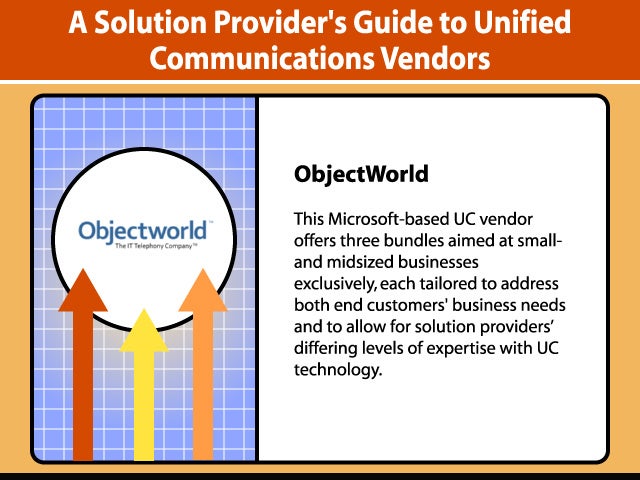 ObjectWorld
ObjectWorld
This Microsoft-based UC vendor offers three bundles aimed at small- and midsized businesses exclusively, each tailored to address both end customers’ business needs and to allow for solution providers’ differing levels of expertise with UC technology.
 Mitel
Mitel
The merger of Mitel and Intertel in 2007 gave solution providers access to the best of both companies’ products from one vendor. The Mitel Application Suite v 1.1 includes Mitel’s telephony and communications package and also incorporates Intertel’s audio and Web conferencing applications.
 Microsoft
Microsoft
Microsoft, not surprisingly, is one of the big names in the UC space. Besides being the compatibility standard, the software giant broke into the space early with Live Communications Server 2005. Microsoft’s latest UC offering is Office Communications Server 2007 (OCS).
 Avaya
Avaya
Avaya offers both Standard and Advanced editions that integrate with leading productivity suites such as IBM Lotus Sametime and Microsoft Office Communicator.
 Nortel
Nortel
Nortel targets medium to large enterprises, and offers two versions of its carrier-hosted offering—one based on Microsoft’s OCS and the other via a partnership with IBM.
 NEC
NEC
NEC’s UC solution offers two options: one designed for larger enterprises and a second designed for businesses with 500 or fewer employees. The technology is sold in two ways: as software only, or as a turnkey product that includes the server hardware. NEC also offers solutions based on Microsoft’s Live Communications Server 2005.
 Cisco
Cisco
The list wouldn’t be complete without mentioning networking giant Cisco. Cisco integrates its UC offerings with CRM, SCM and ERP applications. A new release, version 7.0, includes integration with Microsoft’s OCS as well as plug-ins for IBM Lotus Sametime.
 Unison
Unison
Unison’s solution combines telephony, e-mail and instant messaging in one server and client. In a single system, it aims to replace legacy PBX as well as legacy e-mail servers such as Microsoft Exchange.

